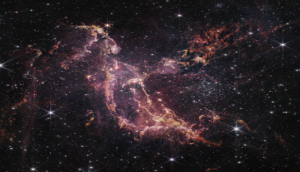
The Indian Space Research Organisation (ISRO) on Tuesday, released fresh set of pictures of impact craters on moon surface taken by tis Chandrayaan 2 Orbiter. While releasing the pictures on its official Twitter handle, the Indian space agency mentioned that the pictures were taken by the Dual Frequency-Synthetic Aperture Rader (DF-SAR).
As per the Indian space agency, the Moon has been continuously battered by meteorites, asteroids and comets since its genesis. Which has caused in the formation of countless impact craters that form the most unique geographic features on its surface.
Impact craters are more or less circular depression on the lunar surface, varying from small, simple, bowl-shaped depression to large, complex, multi-ringed impact basins.
"In contrast to volcanic craters, which result from explosion or internal collapse, impact craters typically have raised rims and floors that are lower in elevation than the surrounding terrain," ISRO said.
The study of the nature, size, distribution and composition of impact craters and associated ejecta features unveiled precious information about the orgin and development of craters.
As per the Indian space agency, weathering processes out turn in many of the crater physical features and ejecta meterial get submerged by layers of reolith (sand, dust, loose rock and soil over a hard surface) making them invisible using optical camera.
ISRO stated, the SAR is a powerful remote sensing device for studing planetary surface and subsurface because of the ability of the rader signal to pierce through the surface. It is also responsive towards roughness, structure and composition of the surface meterial and the buried terrain.
Old lunar-orbiting SAR systems, S-band hybrid -polarimetric SAR on ISRO’s Chandrayaan-1 and the S & X- band hybrid-polarimetric SAR on NASA’s LRO, furnished valued data on the scattering characterisation of ejecta meterials of lunar impact crater, ISRO stated.
#ISRO#Chandrayaan2’s DF-SAR is designed to produce greater details about the morphology and ejecta materials of impact craters on the lunar surface. Have a look of initial images and observations made by DF-SAR
— ISRO (@isro) October 22, 2019
For more details please visit: https://t.co/1j7SBcXIpl pic.twitter.com/SEHukoYJMV
Notwithstanding that, L & S band SAR on Chandrayaan 2 is designed to compose greater details about the morphology and ejecta meterials of impact craters because of its ability of imaging with higher resolution and full polarimetric modes in standalone as well as joint modes in S and l band with eide range of incidence angle analysis.
Furthermore, the substantial depth of penetration of L-band allows probing the covered terrain at extensive depths.
The L&S band SAR payload aids in identifying and quantitatively measure the lunar polar water ice in shadowed area, ISRO said.
"Chandrayaan-2 Orbiter's DF- SAR has been operated in full-polarimetry mode- a gold standard in SAR polarimetry, and is the first-ever by any planetary SAR instrument," ISRO said.
This image presents many interesting facts about the secondary craters of different ages and origins in the lunar south polar region, the space agency said.
"The yellowish tone around crater rims in the image shows ejecta fields. The distribution of ejecta fields, whether uniformly distributed in all directions or oriented towards a particular side of a crater, indicates the nature of the impact," ISRO explained.
According to ISRO, the image shows craters of vertical effect and oblique effect on the top right and bottom right.
Likewise, the roughness of the ejecta meterials associated with the effect craters specifies the degree of weathering a crater has undergone.
Three like sized craters with a row on the bottom right of the picture show specimen of young crater, moderately weathered crater and an old degraded crater.
Many of the ejecta fields seen in the picture cannot be observed in high resolution optical picture over the same region, demonstrating the ejecta fields are covered below regolith layers.
Also Read: SC demands clear picture from govt on how long will restrictions remain in J&K







![BJP's Kapil Mishra recreates Shankar Mahadevan’s ‘Breathless’ song to highlight Delhi pollution [WATCH] BJP's Kapil Mishra recreates Shankar Mahadevan’s ‘Breathless’ song to highlight Delhi pollution [WATCH]](https://images.catchnews.com/upload/2022/11/03/kapil-mishra_240884_300x172.png)

![Anupam Kher shares pictures of his toned body on 67th birthday [MUST SEE] Anupam Kher shares pictures of his toned body on 67th birthday [MUST SEE]](https://images.catchnews.com/upload/2022/03/07/Anupam_kher_231145_300x172.jpg)






